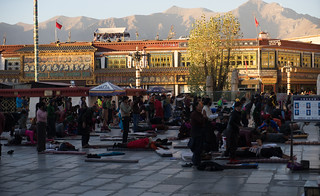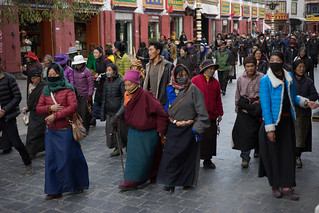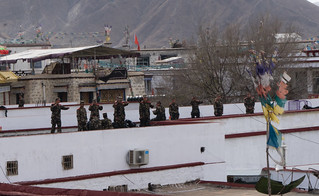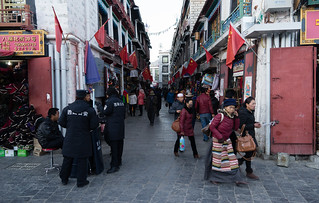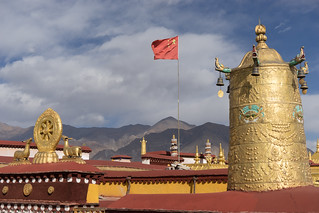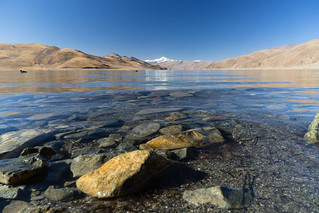We ended our two and a half month journey across Chinese territory with a train ride and then bus tour across the Tibetan Autonomous Region (TAR), the province of China that occupies the southwest portion of the Tibetan plateau and butts against Nepal. We had originally planned to bike across this high altitude region (which has an average elevation of around 15,000 feet), but the Chinese government forbids foreigners to travel independently. If we were to bike it we’d have to pay a jeep to follow us, which is not only prohibitively expensive, but also against the ethos of ride for climate. So we took a train to Lhasa and then joined a bus tour with 10 other young foreign travelers who had also forked over the roughly $1,000 USD per person to visit this semi-forbidden land.
The tour began with two days in Lhasa, where our guide led us around monasteries, the Potala Palace, and the city’s holiest temple. I was especially impressed by the Potala Palace, the former home of the Dali Lama (before he fled in 1959), which was built before the American Revolution and, at 13 stories, is the tallest ancient palace in the world. Few buildings in Lhasa rise higher than two stories. But what was even more impressive than the palace were the pilgrims. In November, there are few foreign or Chinese tourists in Lhasa, but many Tibetan pilgrims (many people in China told us that it was far too cold for us to visit Tibet at this time of year — in general, we found Chinese people unnaturally afraid of the cold, and they always asked us if we were cold if exposed any skin while biking). Apparently, after the fall harvest is when most Tibetans make their pilgrimages to holy sites such as Lhasa (and the Tibetans are far less afraid of the cold).
The holy sites were full of Tibetan pilgrims, and in the tight hallways and rooms of the holy buildings they would often elbow their way around us to stare with wonder at the shrines. In front of the city’s main temple, many pilgrims, young and old, prostrated themselves before the temple, over and over. This involves bringing the hands together in prayer in front of the face, then lying face down on the ground, standing up, and then repeating the motion. To count how many prostrations they do, many pilgrims use prayer beads — every time they lie down on the ground they move a bead on the necklace. An odd number of prostrations is supposed to be auspicious, and most necklaces have several dozen beads. Many of the pilgrims have wooden blocks on their hands, which, like shoes protecting one’s feet, save their palms from the repeated contact with the ground. I was most impressed by some of the prostrating old women, with long, braided hair, and bare hands and feet.
And then there was the kora: In addition to prostrations, Tibetan Buddhists walk clockwise around holy sites in a form of prayer. Around Lhasa’s main temple, a river of people walks in circles like an endless parade. Old women, young girls, men with handheld prayer wheels. A few travel by prostrating themselves and then taking a step, traveling only one body length with each prostration. Needless to say, it takes these people much longer to complete the kora.
The strongest feeling I had in Lhasa was that it was a holy place. It’s hard not to feel swept up in the spirituality of the city, and to want to pray and join the devout. I am agnostic, but I find myself envious of these believers. The second strongest impression was that it isn’t free. Police were everywhere in the city. You had to go through a metal detector to get to the temple (I took a picture of the security check point, and a police officer waved their hands to say “no pictures;” I waved back with what I hoped looked like an ignorant-tourist smile and quickly walked away). And above the courtyard where the old and young prostrated themselves before the temple, police were stationed on the tops of buildings – like snipers. And then there are the flags. I saw more Chinese flags in the TAR than in the rest of China combined. Given how patriotic China is, I was actually surprised by how few Chinese flags we saw crossing the country. That changed in the TAR, where the streets were lined with the red banner. Flags stood on the holy temples and the monasteries, and a large one waved boldly from the top of the Potala Palace. Later, when passing through the countryside, we saw that in half of the villages every house flew the Chinese flag. I talked to some people in town about this — they said that the government forces people to fly them.
In China, we spent a great deal of mental effort trying to reconcile the onerous parts of the Chinese state with the immense good it has achieved in the past few decades. China has one of the least free presses in the world, and we were shocked by the level of censorship. All Google websites and services are blocked, as are Facebook, Twitter, Dropbox, and the New York Times — basically the sites where I spent about 90 percent of my time online (we were able to get around the censors using a VPN, but it was slow and not always reliable). People cannot elect their rulers, and opposing the state can lead to jail or worse. The government executes more than 2,000 criminals per year (although we can’t be sure, as the number is a state secret), and given that prosecution and defense are imperfect, undoubtably many of those people are innocent. China lacks Democracy and Rule of Law — essentially, the institutions that protect people when the government overreaches.
On the other hand, the strong Chinese state has dramatically improved the quality of life of most Chinese citizens over the past three decades (although the quality of life three decades ago in China was very, very low, in no small part because the country had a leader, Mao, who made some very bad decisions, and there was no way to check his rule). Through relatively good leadership, the economy has boomed, and the Chinese have built smooth new roads, countless power plants, efficient metro stations, and new railways. And incomes have risen steadily.
This one-party rule, though, felt much less onerous, and even benevolent, in China’s east, where the population is almost entirely ethnic Chinese (“Han Chinese”). In many ways, the party is just continuing the practices of the empires of old, where a strong emperor and his bureaucracy ruled over China. The emperor was expected to follow Confucian values and rule in the interest of the governed, but the only check on his power was this cultural norm. It seems to me that one reason the Chinese people have accepted one-party rule more than I’d expect them to is that the society is used to such rule. In addition, Chinese/Confucian values place a high value on harmony and order, and people seem to be willing to sacrifice personal freedoms for societal order. At least, that is my impression after crossing the country.
In the TAR, though, the situation is different. The Tibetans are used to worshiping the Dalai Lama as their religious leader and the head of their state. Although Chinese emperors have claimed the TAR as part of their territory for the past few centuries, in reality they exercised relatively little control over the region, and very few Han lived permanently within its borders. From about 1910 to 1950, China exerted almost no control over the TAR, and it operated as an independent country, Tibet. Unfortunately, Tibet was almost entirely closed to the outside world and failed to establish diplomatic relations with other nations, which made it difficult to get allies to protect it from the eventual Chinese invasion.
(This conversation is a bit complicated by the fact that much of the Tibetan Plateau lies outside of the TAR, in parts of the Chinese provinces of Qinghai, Gansu, Sichuan, and Yunnan. About half of ethnic Tibetans live in these provinces. But while they still worship the Dalai Lama and practice Tibetan culture and religion, they have politically been more incorporated into the Chinese state than the Tibetans in the TAR. We biked through Tibetan parts of Qinghai and Gansu provinces, and the police presence, while still uncomfortably high, was much lower than in the TAR.)
In the TAR I felt like we were witnessing colonization in progress. A foreign power has occupied the area, exiled its leader, imposed rule without consulting the citizens, and sent many settlers to take advantage of the region’s resources. In Lhasa, I managed to get some English-speaking Tibetans to tell us about what life is like there. “We have no rights,” said one, and complained that they were not allowed to worship the Dalai Lama. (However, many Tibetans still have images of His Holiness in their homes, and one temple we saw in Gansu Province displayed his picture — we’ve heard that when the police come through to do their routine inspection of the temples, the monks just take the image down.) He also said that Tibetans are not allowed to hold passports — literally, they are not allowed to leave the country. Another person we talked to complained about Chinese mining and dam building, saying it was affecting the climate and upsetting the gods; we heard that one dam was opposed by an important Lama (incarnation), and the Chinese government actually delayed building it until he died. We tried to get our guide to talk about politics, but he declined, saying he might get in trouble — and we heard about guides being spied on to prevent them from telling foreigners stories like the ones I’m writing here.
But I also feel strange defending the old Tibetan system. Before the Chinese invaded, it was an autocratic theocracy, with essentially a feudal system and even some forced labor (that was one way Tibetans paid taxes). You could compare it, in some ways, to many medieval societies. There is a little bit of sick truth to the Chinese double-speak argument that they “liberated” Tibet. They have built infrastructure that has improved the quality of life by many measures. And one of the same Tibetans who said “we have no rights” said that he thought life would be better for his daughters, partially because there is more economic opportunity.
Unfortunately, most people in other provinces have no idea of the extent to which Tibet is a police state, because the state censorship prevents information like this from reaching them.
After our two days in Lhasa, we and ten other tourists from the UK, Brazil, Malaysia, and Australia, boarded a small bus and started motoring towards Nepal. Our bikes, del Fuego and Mini-Momem, rode in the far back, disassembled. We crossed the Brahmaputra River and then climbed over a 4,000 meter pass where we stopped for 20 minutes and I paid $1.40 to get a picture of myself on the back of a yak. We drove by a holy lake with a 6,000 meter peak reflecting in the water, and we visited another monastery before spending the night in Tibet’s second largest city. We then drove on a bumpy dirt road for a few hours to arrive at Mount Everest base camp, where I filled a memory card with images of the mountain.
Along the road, there were numerous checkpoints where our guide had to exit the bus and show papers to police officers. Lindsey and I found ourselves scrutinizing each stop, trying to see if we’d be able to sneak around it if we were on bikes — in the past few years, some cycle tourists have successfully sneaked their way across Tibet by pushing their bikes around these checkpoints in the dead of night. But the police have gotten stricter and surveillance has increased, making such a journey more challenging.
On our final day, we crossed a 5,000 meter pass (16,000 feet) before descending into Nepal, and we convinced our guide to allow us to assemble our bikes and ride down from this pass. The first ten kilometers were some of the greatest riding of my life — wearing down jackets and wind protection, we followed switchbacks beneath the white horizons of the Himalaya. Unfortunately, the road became less steep, and soon a horribly strong headwind made the downhill feel like a climb; the bus had to wait an hour for us, and then our guide didn’t let us ride the second half of the descent — we had to be with our guide at each checkpoint, so they couldn’t simply drive ahead and wait for us at the evening’s destination. We spent the night just nine kilometers from the border, and the next morning we were able to ride from our hotel — of course, we had to wait for our guide to join us before we could cross the border out of China.
Now I am writing this from Nepal, where it feels great to be able to connect to the Internet without government censors, and where we can stay at any hotel we want, not just the ones the state allows to host foreigners.








